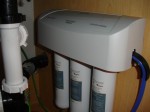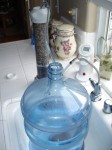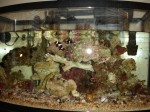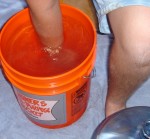One thing you’ll have to do a lot of is water changes, no mater if you’re doing a fresh water, marine, or reef aquarium. I’ve done enough that I’ve got a basic procedure that I go through. My son helps me most of the time. I’m going to document the procedure I go through in this post.
Pure Water
One of the most critical parts of a water change is making sure you have pure water to start with. Where I live, the local city water is quite hard. It also has lots of nitrates, straight out of the tap. As a result, I have to thoroughly pre-treat my water. I learned that reverse osmosis is a good first step. In the picture on the right you can see the under-sink reverse osmosis system that I installed on the kitchen sink. The three replaceable cartridges in this system are two carbon filters before and after a reverse osmosis filter. This system also happens to have a one gallon pressurized tank that keeps the water pressure reasonably high when you’re trying to fill a glass of ice water.
The next step I use is a deionization cartridge. I actually started out just using this deionization cartridge before purchasing the reverse osmosis system. But the cartridge was used up within about 12 gallons of treated water. I learned the hard way what happens if you use an already used up deionization cartridge – it starts transferring all the nitrates that it previously collected into your “filtered” water. Then, you get water that is even more impure than when it started!
From the photo you can see that I have a plastic tube coming out of the normal reverse osmosis spigot, going into the deionization cartridge. The output from the deionization cartridge then goes into a 5 gallon water jug like you would use on a water cooler. I have two of these water coolers so that I can store enough water to conveniently add fresh water to the aquarium when ever the need arises.
This reverse osmosis and deionized water (called RO/DI from now on) is essentially pure water. Even distilled water can collect chemicals from the process of distillation, so you could argue that RO/DI water is as pure or more pure than distilled water.
Removing the Old Water
This is the easy part. Just use a siphon tube to take out about 10% of your water. I use a 5 gallon bucket to pour my water into. That removed water is also a good place to rinse off your pumps, filters, and other things you’ll want to clean at the same time. I throw the waste water into the street in front of my home. You could put it in the drain as well. But I recommend you don’t put waste saltwater on the lawn.
The picture at the right shows my 48 gallon aquarium missing 10 gallons of water. This is 20%, not 10%. I did this when I was diagnosing my calcium trouble I discussed last week. You’ll notice the tallest rocks are a little bit out of the water. This isn’t a problem, even with coral covered live rock. Remember, the tide will often leave the top of coral reefs out of the water for hours at a time. So, your coral can be out of the water for the few minutes it takes to change your water.
If you’re used to a undergravel filtration system for freshwater aquariums you might be tempted to vacuum the substrate while you are changing water. I don’t, though. I figure the bacteria and other stuff in the substrate is much too valuable to remove. If the top is getting a little green, I stir up a quarter inch of substrate every once in a while, being careful not to bury unsuspecting snails or hermit crabs.
Making Saltwater
I use the same bucket to remove old water and to mix new saltwater. So, I have to wait until I’ve discarded the old water to make new water. I rinse the bucket out after discarding the old water. Then, I put RO/DI water into the bucket, and start mixing in saltwater mix. I try to keep the water to about the same temperature as the aquarium water, both to keep from shocking the fish and marine invertebrates, but also so that my hydrometer is accurate. I gradually add salt mix until the specific gravity of the new water is at the same level as the aquarium. If you’re trying to adjust your salinity for some reason, you can go a little low or high, but do this gradually so you don’t shock your guests.
There are other ways to get saltwater. For me, since I live so far away from any reasonably good fish stores, saltwater mix is my best choice. But two of the fish stores I go to sell saltwater. These stores sell the water out of the aquarium systems that is also used for their display aquariums. So, if you live near a good fish store and don’t want to be bothered with making your own saltwater, you can buy it premixed.
If you live near the ocean, you may be tempted to take a bucket out to the beach to get free water! But, I recommend you don’t. Seawater near the coast can have lots of pollutants, including gasoline or diesel from boats, agricultural runoff, and others. Plus, you risk collecting live organisms that you may wish you hadn’t once they get established.
Refilling the Aquarium
Once I’m done mixing water, and I’m satisfied that it’s the correct salinity and temperature, I just pour it into the aquarium. I try to poor fairly slow so I don’t knock live rock over, and unduly stress the fish. I can then put the lighting back on the aquarium and enjoy the nice clean aquarium.
Two or three times a week I also have to add water to compensate for evaporation. For this, I just use the RO/DI water straight out of the water jug. You don’t want to use saltwater to replace evaporation, because the salt is left as water evaporates.




What an interesting description. I’m left wondering; what is the reasoning behind changing 20% of the water at a time, and how often do you change water in order to maintain the desired cleanliness?
Thanks,
Renee
Well… the percentage is somewhat arbitrary. It should be a significant change, but not so much that you shock the aquarium inhabitants.
I did two 20% water changes, one weekend after another, because I found a problem in my weekly water tests that needed to be corrected. But most of the time I’m able to get away with 10% once every 3 weeks. The “bio load”, or the number of live animals I have in the aquarium is relatively low right now, and the filtration system is able to easily keep up with the nitrogen cycle.
The main thing you need to do is check your water chemistry regularly, so that you can tell that your nitrate level is getting high, and that it’s time to change water. See Reef Chemistry 101 for some thoughts on testing your chemicals.
Keep in mind that you are changing only a portion of your water, so your chemicals will only change proportionally. For example, if your nitrate is 40, and you change 10% of your water, your nitrate level will be 36 when you are done (10% of 40 is 4, subtracted from the original level). If you see your chemicals going up too fast, it’s probably time for a larger percentage water change.